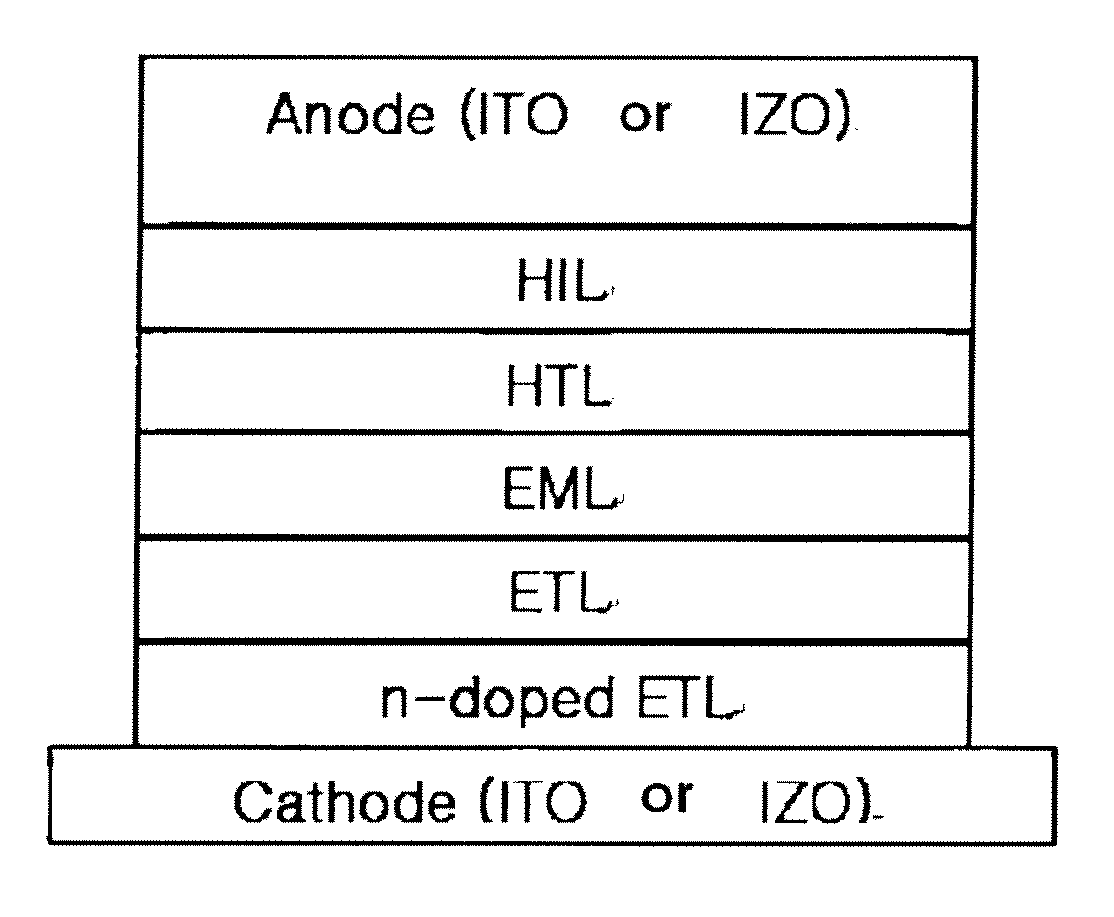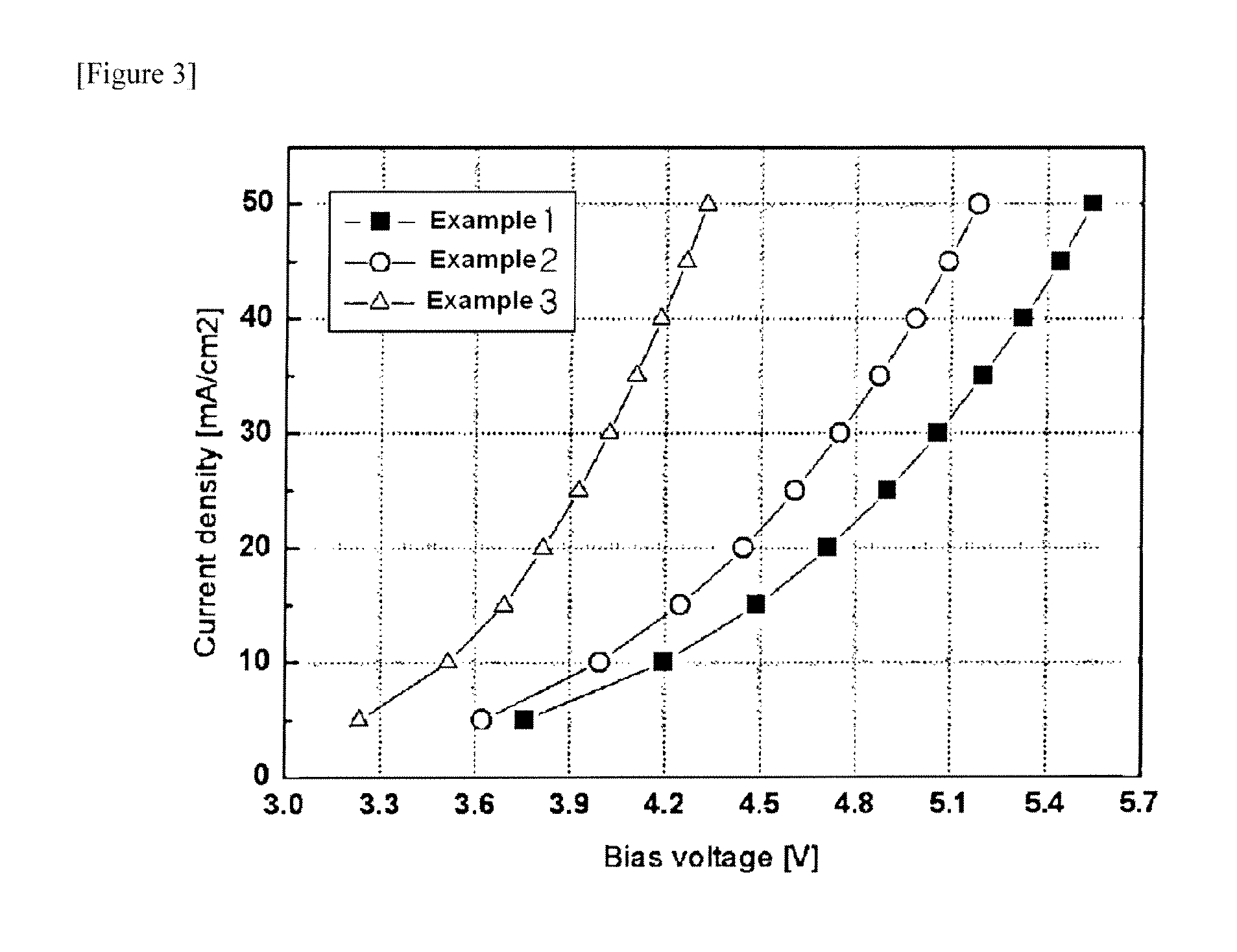Organic light-emitting diode and method of manufacturing the same
a light-emitting diode and organic technology, applied in the direction of luminescent compositions, thermoelectric devices, chemistry apparatus and processes, etc., can solve the problems of deterioration of important diode properties such as light emission efficiency and the like, difficulty in injecting electrons from the cathode to the organic material layer, etc., and achieve high work function
- Summary
- Abstract
- Description
- Claims
- Application Information
AI Technical Summary
Benefits of technology
Problems solved by technology
Method used
Image
Examples
example 1
[0083]The transparent IZO cathode having the thickness of 1000 Å was formed by using the sputtering method on the substrate, and the n-type doped electron transport layer having the thickness of 50 Å was formed thereon by doping Ca on the electron transport material of the following Formula A in an amount of 10% as the first electron transport layer. Subsequently, the second electron transport layer having the thickness of 150 Å was formed on the first electron transport layer by using the electron transport material of the following Formula A.
[0084]In addition, the light emitting layer having the thickness of 300 Å was formed by depositing Alq3 (aluminium tris(8-hydroxyquinoline)) of the following Formula under the vacuum, and the hole transport layer having the thickness of 400 Å was formed thereon by depositing NPB of the following Formula under the vacuum. Subsequently, the hole injection layer having the thickness of 500 Å was formed thereon by depositing the following HAT mate...
example 2
[0087]The transparent IZO cathode having the thickness of 1000 Å was formed by using the sputtering method on the substrate, and the n-type doped electron transport layer having the thickness of 200 Å was formed thereon by doping Ca on the electron transport material of the following Formula A in an amount of 10% as the electron transport layer. In addition, the light emitting layer having the thickness of 300 Å was formed by depositing Alq3 (aluminium tris(8-hydroxyquinoline)) of the Formula of Example 1 under the vacuum, and the hole transport layer having the thickness of 400 Å was formed the on by depositing NPB of the Formula under the vacuum. Subsequently, the hole injection layer having the thickness of 500 Å was formed thereon by depositing the HAT material of Example 1 under the vacuum. The IZO layer having the thickness of 1750 Å was formed thereon. In addition, the transparent IZO anode having the thickness of 1750 Å was formed on the hole injection layer.
[0088]In the abo...
example 3
[0090]The transparent IZO cathode having the thickness of 1000 Å was formed by using the sputtering method on the substrate, and the n-type electron transport layer having the thickness of 200 Å was formed thereon by doping Mg on the electron transport material of the following Formula A in an amount of 10%. The residual steps were the same as those of Example 2.
[0091]The voltage was sequentially applied to the organic light emitting diode that was manufactured in Example 3 at an interval of current density of 0.2 mA / cm2, such that each voltage and brightness leakage current were measured, and the results are shown in FIGS. 3, 4 and 5.
PUM
 Login to View More
Login to View More Abstract
Description
Claims
Application Information
 Login to View More
Login to View More - R&D
- Intellectual Property
- Life Sciences
- Materials
- Tech Scout
- Unparalleled Data Quality
- Higher Quality Content
- 60% Fewer Hallucinations
Browse by: Latest US Patents, China's latest patents, Technical Efficacy Thesaurus, Application Domain, Technology Topic, Popular Technical Reports.
© 2025 PatSnap. All rights reserved.Legal|Privacy policy|Modern Slavery Act Transparency Statement|Sitemap|About US| Contact US: help@patsnap.com



